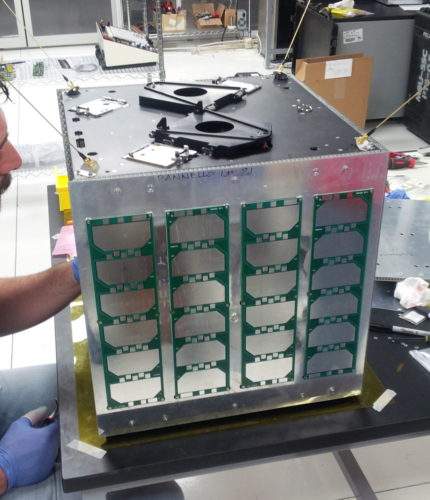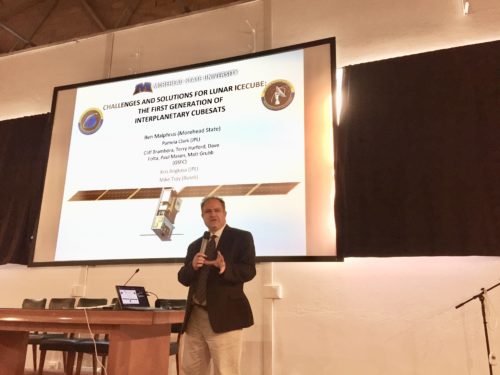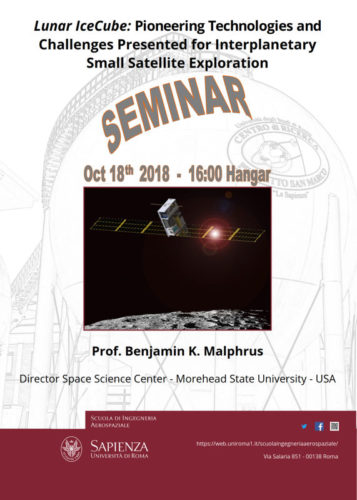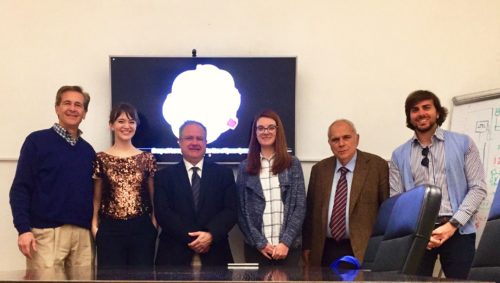GAUSS, a pioneer of the SmallSat community which has contributed to the increase of the development of nano-satellites, attended the Lunar IceCube Seminar on October 18, 2018 at the Scuola di Ingegneria Aerospaziale of Sapienza Università di Roma.
Dr. Benjamin K. Malphrus, Professor of Space Science at Morehead State University (MSU, Kentucky, USA) and Director of its Space Science Center, gave a presentation titled “Lunar IceCube: Pioneering Technologies and Challenges Presented for Interplanetary Small Satellite Exploration”.
During the Seminar, Prof. Malphrus, who is leading the Lunar IceCube scientific mission and who has a great expertise in the field of nano-satellites, presented the innovative Exploration Mission of a 6U CubeSat designed to investigate the presence of water, ice and other resources on the surface of the Moon, once deployed from NASA’s Space Launch System rocket (SLS) where it will be launched as a secondary payload next December. The scientific aim is to look for water and the physics of transport.
This mission is a joint effort by MSU and NASA personnel and is one of NASA’s Next Space Technologies for Exploration Partnerships Projects.
LunarIceCube will be one of the first small satellites to explore deep space, paving the way of future small-scale planetary missions.
Such an ambitious project shows that not only CubeSats continue providing valuable experiences but are also expected to expand their potential with interplanetary flights.
Moreover, MSU, together with Rajant Corporation, is carrying out an exchange program for outstanding Italian engineering students and recruiting aerospace engineering talents for US companies to collaborate in the small satellite technology field.
GAUSS and MSU Space Science Center collaborations along the way

UNISAT-5 EM at the Space Science Center, Morehead, KY
GAUSS (first as a School’s University laboratory and right after as a Private Company) cooperated with Professor Malphrus in fruitful occasions: back in 2011 with GlioLab, a GAUSS, KySpace and MSU joint project, which dealt with a Space biomedical research, including its testing on a Space Shuttle mission.
In 2013, UniSat-5 Mission was initially designed and developed at the MSU Space Science Center, where the newly-formed GAUSS Company started working on the idea of a micro-satellite able to carry in orbit other small-sats, like PocketQubes.
The fifth small spacecraft mission of the UNISAT Program was the first one that deployed CubeSats and PocketQubes (Eagle-1, Eagle-2, $50-Sat, WREN, QBScout) and was launched from Russia in November 2013.
GAUSS personnel was kindly hosted by Dr. Malphrus’ Space Science Center for several months during the initial design of the platform.
On top of being an eminent scientist with distinguished experience in SmallSat missions, Professor Benjamin Malphrus is also part of the Scientific Committee of GAUSS series of IAA Conferences on University Satellites Missions and CubeSat Workshop.
For people at GAUSS it is a great opportunity to meet again Prof. Malphrus after the latest CubeSat Conference GAUSS hosted in Rome and the many projects on which they have cooperated together.



